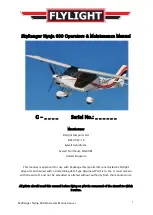
42
little too much, the glider will enter a Full Stall. If you release the brakes too much, the glider
will go back to normal flight. To practice a deep stall, it is necessary to master the full stall first.
A very old or worn out glider with a porous cloth or with a changed trim (due to many winch
launches, or deep spirals) might stay in a deep stall even after releasing both brakes. Do not
apply the brakes in such a situation, because the wing would then enter a full stall! You can exit
the deep stall by pushing the speed bar, or by simply pushing the A-risers forward or pushing
the accelerator. If you fly through rain, the risk of a deep stall is higher.
We strongly advise against flying in rainy conditions
. If it happens that you get into rainfall,
we recommend not to perform Big Ears. The best is to leave the rain as soon as possible, and to
fly with both brakes released, or even accelerated, as this reduces the risk of a deep stall. (The
available brake travel before entering a deep stall may be reduced significantly.)
Summary of Contents for PURE III
Page 2: ...1 ...
Page 4: ...3 ...
Page 26: ...25 ...
Page 28: ...27 ...
Page 36: ...35 ...
Page 51: ...50 ...
Page 52: ...51 A ANHANG ANNEX a Übersichtszeichnung Overview ...
Page 53: ...52 b Leinenplan line plan ...
Page 54: ...53 ...
Page 55: ...54 ...
Page 56: ...55 ...
Page 57: ...56 ...
Page 59: ...58 ...
Page 60: ...59 ...
Page 61: ...60 Faltleinen Plan Folding Lines Plan ...
Page 63: ...62 d Tragegurt RISER ...
Page 66: ...65 C Erklärung über Bauausführung und Leistung EBL Declaration of Design and Performance DDP ...
Page 67: ...66 ...
Page 72: ......










































